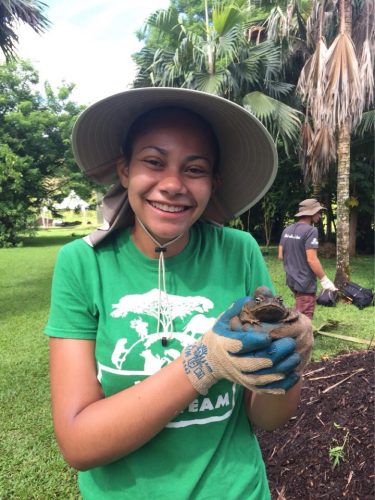
I am a half black, half white woman. My skin is tan, my hair is a dark shade of brown, my nose is a bit large, and my figure has been described as “big-boned” on more than one occasion. Very rarely will someone correctly guess my race at first glance, so many people consider me to be racially ambiguous.
Of all the races I have been assumed to be, Hawaiian was never one until I arrived in Kaua’i, Hawai’i, for DukeEngage. From locals at work to tourists on the beach, I have been assumed to be a native Hawaiian, or at least a local, multiple times since arriving four weeks ago.

But, what does it mean to be a local in Kaua’i? This question intrigues me because semantics are powerful and important but very difficult to nail down especially since this place and culture are so new to me. The following are my running definitions of key labels:
Native Hawaiians are locals but locals can also be people who have been on the island for many years or even generations and have established themselves in the community. Locals can be a variety of different races. Residents include all the locals but also include people who are new to the island or have not yet established themselves in or been accepted by the inner cultural circles. Outsiders can be tourists but also can be non-native Hawaiians in general depending on whom you ask.
Based on my four weeks of observations thus far, tensions still exist between some natives and outsiders in Kaua’i, tensions which mainly stem from the overthrow of the Hawaiian monarchy over a century ago by United States military forces. Today, people from the continental U.S. and abroad, predominately white people, are viewed differently, and in many instances suspiciously, by some natives. It is interesting to me that, even though I have only been in Kaua’i for a brief time, strangers would sooner consider me a local than a white person who has been working on this island for many years simply because of the color of my skin.
Last week I saw an example of the racial and cultural divide still present between certain groups here in Kaua’i. An old friend and colleague of my supervisor came to visit our office at the Hanalei Watershed Hui. He is a very nice white man from the continental U.S. who has been aiding communities and organizations in the North Shore of Kaua’i for years by doing technical work and providing drone footage. After hearing about all the projects he is involved with on the island, I was surprised to learn that he had recently had an upsetting encounter with a native Hawaiian he had been assisting.
In an email exchange, the native man reminded our visitor that he is still an outsider who has much to learn about Hawaiian culture and the practice that one gives before one takes. Having felt that he was finally being accepted into the community, this conversation was a harsh wake-up call for the visitor.
I call the man a visitor not only because he was a visitor to our office last week but because he is still a visitor to this island despite having engaged with communities in Kaua’i for many years. I am a visitor as well, but the color of my skin has afforded me some misplaced acceptance in certain spaces I have encountered while on the island.
Despite my efforts to learn as much about Hawaiian culture as I can in four short weeks, I am ignorant in many ways. I bob my shoulders in hula class and I am more focused on learning the steps at the moment than the cultural meanings behind the songs. I ask locals to pronounce their names “just one more time” or even spell them because the similarities between names and letters are still foreign to me. I am learning more every day, but I am a lifetime away from being accepted as a local and I will never be a native despite what people assume at first glance.
The historical significance of Kaua’i as an island where Hawaiians come to regroup and seek sanctuary has drawn the attention of non-natives. People of a variety of races have come from around the globe and now call this place home. Will these visitors ever truly be accepted into the native communities or will the past tensions continue to divide Hawaiian residents, native and not? How far back must someone’s lineage go before the color of his or her skin stops being a determining factor of the amount of aloha in his or her heart?
The idea of acceptance is much easier talked about than practiced. The United States’ takeover of the Hawaiian Islands is still fresh in the minds of the natives, especially the elders, which is why the Hawaiian nationalism movement exists. Time will only tell if the native Hawaiians regain their homeland or if they decide to accept non-natives into their communities as equals. The decision to become a Hawaiian nation or remain a state in the U.S. should be entirely up to the natives, in my opinion, but politics are complicated and change does not come swiftly. So, for the immediate future, my hope is that the residents of Kaua’i can find common ground and live with the values of aloha regardless of their ancestry. Perhaps at that time, it will take more than a quick glance to determine the locals from the visitors.

